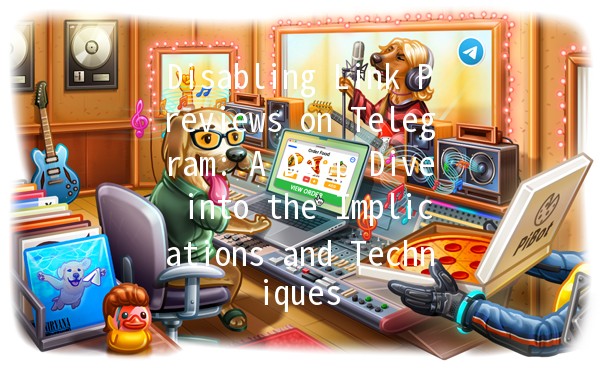Disabling Link Previews on Telegram: A Deep Dive into the Implications and Techniques

In the age of rapid digital communication, messaging applications like Telegram have transformed the way we connect, share, and consume content. One notable feature of Telegram is its ability to generate link previews, which display a snippet of the content linked when users share URLs. While these previews can enhance engagement and provide context, there are instances when disabling link previews becomes not only advantageous but necessary. In this article, we will explore the reasons for disabling link previews, the methods to achieve this, and the implications for users and communities.
Understanding Telegram Link Previews
Before delving into the mechanism of disabling link previews, it's essential to grasp what link previews entail and their role in the Telegram ecosystem. When a user shares a link in a Telegram conversation, the platform automatically pulls metadata from the linked page, which often includes an image, title, and description. This instant visual and informational summarization serves several purposes:
Despite these advantages, there are valid reasons why users might wish to disable link previews.
Reasons for Disabling Link Previews

How to Disable Link Previews on Telegram
The process for disabling link previews on Telegram can vary based on the platform (mobile or desktop) and the desired context (individual chats versus groups). Below, we outline various methods for achieving this.
For Individual Chats
Open the chat where you intend to share your link.
Type your message in the text box.
Before sending, longpress the link. A menu will appear.
Select the option to disable the preview (usually indicated by "Disable link preview").
Open the chat window in the Telegram desktop application.
Enter your message along with the link.
After you paste the link but before sending it, look for the preview image at the bottom.
Click on the 'X' or a similar icon to remove the preview before sending.
For Group Chats and Channels
When posting in group chats or channels, the process may be slightly different:
Use Markdown Formatting: By using Markdown formatting, you can share links without generating previews. Links can be embedded in text, allowing for a clean presentation.
Advanced Settings: Some channels and groups may allow administrators to disable link previews for all messages. This feature, if available, can be accessed through the group or channel settings.
The Impact of Disabling Link Previews
The decision to disable link previews carries several implications, both for individual users and for broader community communication.
For Individual Users
Improved Privacy: Users can communicate without inadvertently sharing more information than they intend, enhancing their overall privacy.
Tailored Communication: By opting out of link previews, users can craft messages that fit their style and preference without the disruption of autogenerated content.
For Communities and Groups
Enhanced Focus on Content: In groups with a high volume of shared links, disabling previews can help keep discussions on track and focused on the topic rather than the distractions of visual clutter.
Maintaining Trust: By preventing the automatic generation of previews, communities can foster a more secure environment where users are less likely to encounter misleading or malicious links.
Considerations for Content Creators
Content creators should consider the ramifications of disabling link previews. While it can mitigate privacy issues and allow for greater control over how their work is presented, it also eliminates a tool that can drive engagement. Creators should strike a balance based on their professional goals:
Disabling link previews in Telegram is a nuanced decision that can enhance user privacy, maintain aesthetics, and reduce distractions in conversations. While the feature of link previews introduces efficiency and engagement in sharing content, it also presents challenges that necessitate careful consideration. By understanding the methods to disable this feature and the implications of such a decision, users can refine their communication strategies in ways that align with their personal preferences and community needs.
The next time you share a link on Telegram, think about whether a link preview serves your purpose or if it detracts from your message. This choice ultimately fosters a richer, more focused digital dialogue, creating a more mindful environment for all users involved.
Other News

如何在TelegramX中进行群组投票 🤖📊

Telegram安装时间优化 🚀📱

Telegram Mac版下載地址及其特色功能探索!
